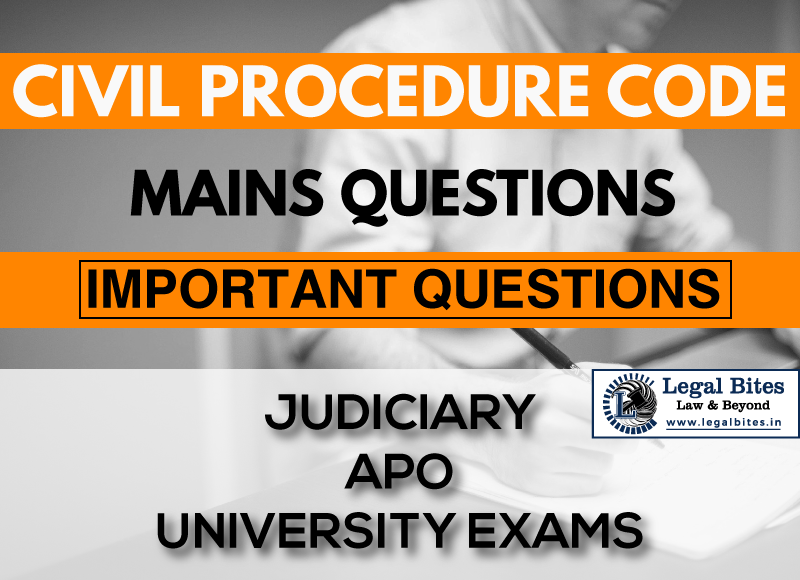Explain the general rules as to the institution of the suit under Section 16 to 20 of C.P.C.
Question: Explain the general rules as to the institution of the suit under Section 16 to 20 of C.P.C. [U.P.C.J. 1987, UPHJS, 2000] Or Explain the provisions of C.P.C. which are applied in determining the forum for the institution of suit relating to immovable property. Find the answer to the mains question only on Legal Bites. [Explain the general… Read More »

Question: Explain the general rules as to the institution of the suit under Section 16 to 20 of C.P.C. [U.P.C.J. 1987, UPHJS, 2000] Or Explain the provisions of C.P.C. which are applied in determining the forum for the institution of suit relating to immovable property. Find the answer to the mains question only on Legal Bites. [Explain the general rules as to the institution of the suit under Section 16 to 20 of C.P.C.] Answer Section 15 to 20 of the Code of Civil Procedure regulate the...
Question: Explain the general rules as to the institution of the suit under Section 16 to 20 of C.P.C. [U.P.C.J. 1987, UPHJS, 2000] Or
Explain the provisions of C.P.C. which are applied in determining the forum for the institution of suit relating to immovable property.
Find the answer to the mains question only on Legal Bites. [Explain the general rules as to the institution of the suit under Section 16 to 20 of C.P.C.]
Answer
Section 15 to 20 of the Code of Civil Procedure regulate the forum for the institution of suits. Section 15 requires the plaintiff to file a suit in the court of lowest grade competent to try it. Section 16 to 18 deals with suits relating to immovable property. Section 19 applied to suits for compensation for wrong to person or to movable property. Section 20 is a residuary section and covers all cases not dealt with by sections 15 to 19.
Section 16 to 18 deals with suits relating to immovable property. Clauses (a) to (e) of section 16 deal with the following five kinds of suits, viz:
- for the recovery of immovable property with or without rent or profits,
- for the partition of immovable property,
- for foreclosure, sale or redemption in the case of a mortgage of or charge upon immovable property,
- for the determination of any other right to or interest in immovable property,
- for compensation for wrong to immovable property,
- for the recovery of movable property actually under distraint or attachment,
These suits must be filed in the court within the local limits of whose jurisdiction the property is situated.
Section 17 provided for the contingency when the property is situated in more than one jurisdiction. It says that where a suit is to obtain a relief respecting, or damage for torts to, immovable property situated within the jurisdiction of different courts, the suit can be filed in the court within the local limits of whose jurisdiction any portion of the property is situated provided the suit is within the pecuniary jurisdiction of such court.
Furthermore, a case in which it is not certain as to the place where the property is situated within the jurisdiction of one or the other of several courts, then as per section 18, one of these courts it is satisfied that there is such uncertainty, may after recording a statement to that effect proceed to entertain and dispose of the suit.
With respect to movable property, it has been said that movables follow the person (mobilia sequuntur personum), section 19 states that where a suit is for compensation for the wrong done to the person or to movable property if the wrong was done within the local limits of the jurisdiction of one Court and the defendant resides, or carries on business, or personally works for gain, within the local limits of the jurisdiction of another Court, the suit may be instituted at the option of the plaintiff in either of the said Courts.
Section 20 covers all other cases not covered by any of the foregoing rules. All suits may be filed at the plaintiff’s option in any of the following courts, viz:
- the defendant, or each of the defendants where there are more than one, at the time of the commencement of the suit, actually and voluntarily resides, or carries on business, or personally works for gain; or
- any of the defendants, where there are more than one, at the time of the commencement of the suit, actually and voluntarily resides, or carries on business, or personally works for gain, provided that in such case either the leave of the Court is given, or the defendants who do not reside, or carry on business, or personally works for gain, as aforesaid, acquiesce in such institution; or
- The cause of action, wholly or in part, arises.
Important Mains Questions Series for Judiciary, APO & University Exams
- CPC Mains Questions Series: Important Questions Part – I of X
- CPC Mains Questions Series: Important Questions Part – II of X
- CPC Mains Questions Series: Important Questions Part – III of X
- CPC Mains Questions Series: Important Questions Part – IV of X
- CPC Mains Questions Series: Important Questions Part – V of X
- CPC Mains Questions Series: Important Questions Part – VI of X
- CPC Mains Questions Series: Important Questions Part – VII of
- CPC Mains Questions Series: Important Questions Part – VIII of X
- CPC Mains Questions Series: Important Questions Part – IX of X
- CPC Mains Questions Series: Important Questions Part – X of X
Admin Legal Bites
Legal Bites Study Materials correspond to what is taught in law schools and what is tested in competitive exams. It pledges to offer a competitive advantage, prepare for tests, and save a lot of money.

